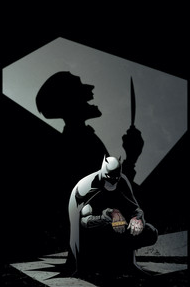 The incredible guys at COMIC BOOK RESOURCES had a chance to talk to Scott Snyder about the his role in the new Joker story line ENDGAME and the acclaimed writer talks about his unconventional origin story for Joker that he hinted in BATMAN #38 this month. Here is the interview highlights. (WARNING…SPOILERS AHEAD!):
The incredible guys at COMIC BOOK RESOURCES had a chance to talk to Scott Snyder about the his role in the new Joker story line ENDGAME and the acclaimed writer talks about his unconventional origin story for Joker that he hinted in BATMAN #38 this month. Here is the interview highlights. (WARNING…SPOILERS AHEAD!):
CBR News: In “Batman” #38, you explain that the Joker virus is unique in that it heals The Joker even as it slowly kills its victims. It’s a complete inverse, like life and death and comedy and tragedy and, really, like Batman and The Joker. Why is it human nature to be so fearful of our polar opposite?
Scott Snyder: Part of the point of “Endgame” is that The Joker now positions himself as a stranger to Batman. “You don’t know me at all, and I know everything about you.” That’s terrifying not only because he’s a reflection of Batman, but suddenly he’s become this obscured reflection. It was always his message in “Death of the Family” and earlier in continuity, that, “We are two sides of the same coin. I’m doing this because I make you stronger.”
But this time, he something’s different. “All I am is the unknown.” Now, he’s this stranger that knows Bruce very well, and knows his weaknesses. I don’t think there is anything scarier than somebody coming after you that knows what you are most afraid of, and is happy to bring that to your doorstep.
While he’s often portrayed as crazy and the Clown Prince of Gotham, this time around, we’re seeing a more calculated approach to his mayhem.
I’ve actually never really seen him as crazy. I see him as evil. I think people like to think he’s crazy because we’re less comfortable with the idea that somebody could be deeply evil. You so rarely see absolute lack of empathy and compassion in a character that is operating with gleeful malevolence. That is something that just goes completely against our nature to believe in another human being. The Joker is that. In my interpretation, The Joker never says he’s crazy. He more, unapologetically, says, “This is who I am.” He very much has reasons for doing the things that he does, which make sense in his relationship with Batman. But I don’t think he views himself as crazy, and I don’t think Batman thinks he’s crazy either. The public perception of him is that he is a lunatic, but deep down, he’s actually very evil.
Speaking of crazy, we also get the New 52 debut of Crazy Quilt in this issue, a much maligned supervillain since his debut in 1946. Why mine Batman’s past to find these gems when building a story arc like “Endgame,” as opposed to creating new adversaries like the Court of Owls?
That’s a great question. For me, this story is meant to be somewhat celebratory, as dark and twisted as it is. It started as a celebration of Batman’s 75th anniversary, and it ends as a celebration of Joker’s 75th anniversary…
…Crazy Quilt was perfect because I needed a character that was really Frankenstein-ian. I needed a doctor that Batman believes must have helped Joker make this inverse strain. Joker must be taking something that is giving him this ability to heal and letting him make this argument that he is ancient. When he targets Dekker, he’s sure that he’s right: This is the person that did it. But even though Dekker admits that he helped Joker make the virus, what he says that stuns Batman is, “The substance in the virus, it’s from him. I got it from The Joker’s body… from his spine. He found it long ago. He is who he says he is.” Because Crazy Quilt is so integral to the story, you forgot the silliness of him. ..
…Again, this story, albeit very twisted, is meant to be fun. Even though Joker said “Death of the Family” is a comedy and “Endgame” is a tragedy, for him, he revels in tragedy, so “Death of the Family” must have been more uncomfortable for him. That story was more grim and dark, and this story is more eye-popping and silly and fun. And it only gets more so. You’ll see a lot more nuttiness as the story moves forward. I wanted this to be a big birthday party for The Joker and Batman, because this will definitely be the last time I ever write The Joker.
Well, looking at the cover for “Batman” #40, it’s fairly mythic.
I love that cover. I told Greg that I wanted it to be like Batman and The Joker had turned into completely mythological figures, something that you would see portrayed in a stained glass window. I wanted it like they are fighting deep in the pages of an ancient story, because again, this will be the last time we use The Joker. “Death of the Family” was the first part of a story, and I intended to do something with The Joker that was more of a tragedy in the second part. But when I started working on this one, which basically started when I was finishing the first one, I quickly realized that this one was going to be the one when nothing is left on the table. Everything that Joker didn’t do or said he wouldn’t do — and I don’t mean not kill people — but everything and anything is possible. The consequences of this one change everything. In “Death of a Family,” he gave Batman a chance. In this one, there are no chances. This one is about tearing everything down, for The Joker. And a lot of it does get torn down, and what comes out on the other side and what it leads to, the transformative aspects to the story, is very, very big.
I know from talking to you about “The Wake” that you love science and biology, so when I see such a well-defined, scientific explanation for the Joker virus based on jellyfish physiology, I know you’ve done your research. Do you have a team of scientists working for you?
[Laughs] No team, but I actually did a lot of research on that science. Again, the story has been planned for over a year and I love the idea of making it somewhat plausible. That gene, LIN28, is real. It’s one of the key genes that they’ve found in mice to be responsible for regenerative abilities for lost limbs. The idea of the cellular matrix and magic dust is all speculative stuff that is fun to read about. I really wanted to make something that links the mythology of some different aspects of “Batman” in a way that could be true and could be not true, because Crazy Quilt is crazy. At the same time, his belief that the Lazarus Pit is a corrupted version of this substance or has this substance in it, and the electrum that the Owls have possibly have this substance in it. And there is the idea that Vandal Savage was possibly touched by this substance long ago, and that’s why he is this immortal figure, which is how Grant [Morrison] positioned him in the cave.
This story really is a goodbye to a lot of things that we’ve built, and lots of the status quo, and it’s a celebration at the same time. I just want it to be as big as we ever go. AWe can pull back with a new status quo in June. It’s almost time to start over, in a way. I want people to say, “I did not know that they had that in them, to try something that nutty in their fifth year on the book” — my fifth year, Greg’s fourth.
Traditionally in the DCU, Batman and Joker have been portrayed as wickedly clever and resourceful. But in this arc, you’re basically making Joker a super threat in terms of strength and immortality. How does that change the Batman/Joker dynamic?
One of the things that is almost unspoken between Bruce and Dick is the question of, “Did we just miss our chance to kill him?” Or is it possible that The Joker always had this substance in him and it wouldn’t have worked any way? He would have just got up and laughed. Ultimately, now he is kind of reveling in the fact that you cannot take him down. He is this character that has a much longer history than you would think.
The other reason that it’s deeply scary, and why he’s chosen to flaunt it in front of Batman, whether or not it’s true, is because he believes very much that Batman’s biggest problem, his biggest fear, is his own mortality. He’s tried to transform himself into a symbol that extends beyond his own body and extends beyond his own life, and not in a way that he is afraid of dying. Bruce is afraid of losing Batman to his own body as he gets older. He’s afraid that he’ll go down fighting, but he won’t be strong enough, he won’t be fast enough. He isn’t exactly the legend that Batman has become. He’s still, ultimately, physically defined by his own body. He’s a person, and The Joker is saying that. He’s saying, “I know who you are. You’re nothing. You’re reduced to being just Bruce Wayne. I’m something much bigger than you — and I always have been.”
(This is just a partial transcript. The whole article (and pictures) can be accessed HERE)
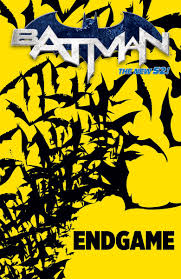 The guys at Comic Book Resources had a very nice interview with DC writer Scott Snyder about the new storyline
The guys at Comic Book Resources had a very nice interview with DC writer Scott Snyder about the new storyline

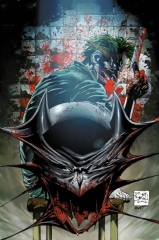
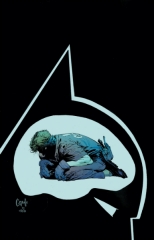
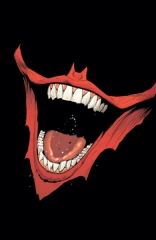
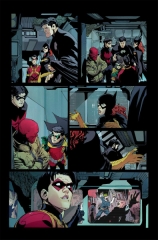
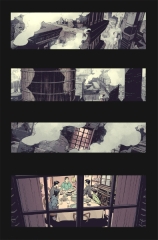
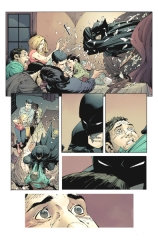
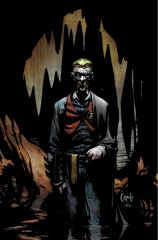
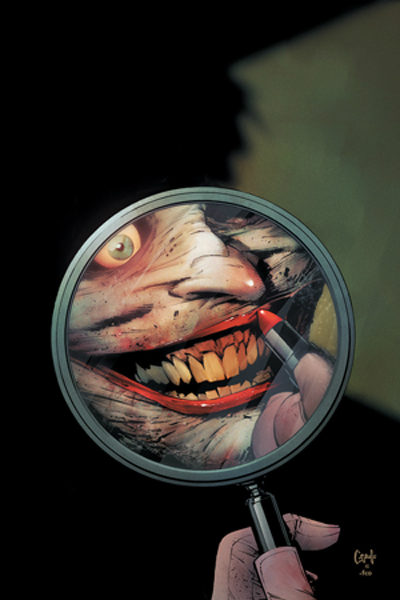 \
\